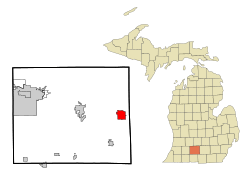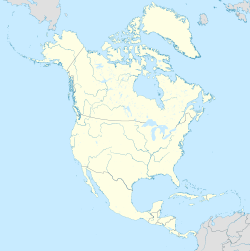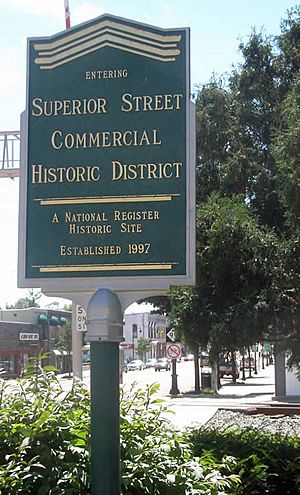Albion, Michigan facts for kids
Quick facts for kids
Albion
|
|
|---|---|
|
City
|
|

Location of Albion, Michigan
|
|
| Country | United States |
| State | Michigan |
| County | Calhoun |
| Area | |
| • Total | 4.50 sq mi (11.66 km2) |
| • Land | 4.41 sq mi (11.42 km2) |
| • Water | 0.09 sq mi (0.24 km2) |
| Elevation | 951 ft (290 m) |
| Population
(2020)
|
|
| • Total | 7,700 |
| • Density | 1,746.03/sq mi (674.14/km2) |
| Time zone | UTC-5 (Eastern (EST)) |
| • Summer (DST) | UTC-4 (EDT) |
| ZIP code |
49224
|
| Area code(s) | 517 |
| FIPS code | 26-00980 |
| GNIS feature ID | 0619906 |
Albion is a city located in Calhoun County, in the southern part of Michigan. In 2020, about 7,700 people lived there. Albion is part of the larger Battle Creek area.
Early English-speaking settlers called this area The Forks. This is because two branches of the Kalamazoo River meet here. Over time, people from many different countries moved to Albion. In the early 1900s, immigrants came from Eastern European nations like Lithuania and Russia. More recently, people have moved from Mexico and Central America.
Every year since 1967, Albion celebrates its diverse heritage with the Festival of the Forks. For a long time, Albion was known as a factory town. Many big factories were built here. Today, Albion is becoming more of a college town. People in Albion are very interested in technology and protecting the environment. Albion College is a private college in the city with about 1,250 students. Albion is also a sister city with Noisy-le-Roi, France.
Contents
History of Albion
Early Settlers and Naming
The first European-American settler, Tenney Peabody, arrived in 1833. He came with his brother-in-law, Charles Blanchard, and another young man, Clark Dowling. Peabody's family joined them soon after. In 1835, a company called the Albion Company planned out a village. They asked Peabody's wife to name the new settlement. She thought about "Peabodyville" but chose "Albion" instead. This name came from where Jesse Crowell, who started the company, used to live. Crowell became the first postmaster in 1838.
Many early settlers moved to Albion from New York and New England. They came after the Erie Canal was built, which opened up new lands in Michigan. These settlers first focused on farming. Albion became a small village where farmers could trade their goods.
Albion College and Growth
The settlers believed strongly in education. In 1835, the Methodist church started Albion College. The first classes were held in 1843. The college had a few different names before 1861. In 1861, it was allowed to give four-year degrees to both men and women.
Albion became an official village in 1855. This happened after a railroad was built there in 1852, which helped the town grow. Albion became a city in 1885.
Industry and Floods
Mills were built along the Kalamazoo River to use the water power. These mills were the first industries in Albion. They processed lumber, grain, and other products needed to build the village. Albion quickly became a mill town and a place for farming trade.
However, the river that powered the industries also caused floods. In 1908, a very big flood hit Albion. Heavy snow fell in February, and then warm weather and rain in March caused the rivers to rise. The Homer Dam broke on March 7, and the Kalamazoo River flooded Albion. Bridges went underwater, and six buildings collapsed. The damage was very costly, and the town worked hard to recover.
Factories and Community Spirit
In the late 1800s and early 1900s, many immigrants from Lithuania and other Eastern European countries moved to Albion. Most of them worked for the Albion Malleable Iron Company. This company first made farm tools. Around World War I, it started making parts for cars. Today, the company still makes car parts in Albion. Downtown, there is a park called Molder Statue Park. It honors the many workers who handled hot iron.
Enough Lithuanians lived in town to build Holy Ascension Orthodox Church in 1916. Its services are now in English.
Albion's population was largest in 1960. In 1973, Albion was named an All-America City. This award recognized the city's great community efforts. Michigan Governor William Milliken and other important people came to celebrate in 1974. In 1975, a big factory closed. This made it harder for people to find jobs, and the population started to decrease.
Since then, citizens have worked together to help Albion. They started the Albion Community Foundation in 1968. In the 1980s, they formed the Albion Volunteer Service Organization. These groups help the community deal with economic challenges.
Key to the City Honors
Important visitors to Albion have received the "Key to the City." This is a special honor.
- In 1964, Aunt Jemima visited Albion.
- In the 1960s, writer Ann Landers received a key when she visited Starr Commonwealth for Boys.
Geography
Albion covers about 4.51 square miles (11.66 square kilometers). Most of this area is land, with a small part being water. Albion is located at 42.24 degrees north of the equator and 84.75 degrees west of the prime meridian.
Climate
| Climate data for Albion | |||||||||||||
|---|---|---|---|---|---|---|---|---|---|---|---|---|---|
| Month | Jan | Feb | Mar | Apr | May | Jun | Jul | Aug | Sep | Oct | Nov | Dec | Year |
| Average precipitation inches (mm) | 2.62 (67) |
1.91 (49) |
2.08 (53) |
3.25 (83) |
4.12 (105) |
4.06 (103) |
4.20 (107) |
4.15 (105) |
3.27 (83) |
3.49 (89) |
2.72 (69) |
2.42 (61) |
38.29 (974) |
| Average snowfall inches (cm) | 15.2 (39) |
6.9 (18) |
5.2 (13) |
1.0 (2.5) |
0.0 (0.0) |
0.0 (0.0) |
0.0 (0.0) |
0.0 (0.0) |
0.0 (0.0) |
0.1 (0.25) |
1.5 (3.8) |
10.5 (27) |
40.4 (103.55) |
| Average extreme snow depth inches (cm) | 8.4 (21) |
6.5 (17) |
3.4 (8.6) |
1.1 (2.8) |
0.0 (0.0) |
0.0 (0.0) |
0.0 (0.0) |
0.0 (0.0) |
0.0 (0.0) |
0.1 (0.25) |
1.2 (3.0) |
5.3 (13) |
10.1 (26) |
| Average precipitation days (≥ 0.01 in) | 12.5 | 9.0 | 8.8 | 11.6 | 12.3 | 10.6 | 9.9 | 10.4 | 9.5 | 11.4 | 10.5 | 11.7 | 128.2 |
| Average snowy days (≥ 0.1 in) | 6.1 | 4.0 | 2.3 | 0.4 | 0.0 | 0.0 | 0.0 | 0.0 | 0.0 | 0.0 | 1.0 | 4.3 | 18.1 |
| Source 1: NOAA | |||||||||||||
| Source 2: National Weather Service | |||||||||||||
Population and People
| Historical population | |||
|---|---|---|---|
| Census | Pop. | %± | |
| 1850 | 881 | — | |
| 1880 | 2,716 | — | |
| 1890 | 3,763 | 38.5% | |
| 1900 | 4,519 | 20.1% | |
| 1910 | 5,833 | 29.1% | |
| 1920 | 8,354 | 43.2% | |
| 1930 | 8,324 | −0.4% | |
| 1940 | 8,345 | 0.3% | |
| 1950 | 10,406 | 24.7% | |
| 1960 | 12,749 | 22.5% | |
| 1970 | 12,112 | −5.0% | |
| 1980 | 11,059 | −8.7% | |
| 1990 | 10,066 | −9.0% | |
| 2000 | 9,144 | −9.2% | |
| 2010 | 8,616 | −5.8% | |
| 2020 | 7,700 | −10.6% | |
| Source: Census Bureau. Census 1960- 2000, 2010. | |||
Population by Age and Gender (2010)
| Male | 4,013 | 46.6% |
| Female | 4,603 | 53.4% |
| Under 18 | 1,872 | 21.7% |
| 18 and over | 6,744 | 78.3% |
| 20-24 | 1,364 | 15.8% |
| 25-34 | 842 | 9.8% |
| 35-49 | 1,251 | 14.5% |
| 50-64 | 1,368 | 15.9% |
| 65+ | 1,124 | 13.0% |
Population by Ethnicity (2010)
| Hispanic or Latino | 500 | 5.8% |
| Non Hispanic or Latino | 8,116 | 94.2% |
Population by Race (2010)
| White | 5,477 | 63.6% |
| African American | 2,579 | 29.9% |
| Asian | 91 | 1.1% |
| American Indian and Alaska Native | 29 | 0.3% |
| Native Hawaiian and Other Pacific Islander | 17 | 0.2% |
| Other | 90 | 1.0% |
| Identified by two or more | 333 | 3.9% |
Transportation
Main Roads
 I-94
I-94 BL I-94
BL I-94 M-99
M-99- M-199
Train Service
Amtrak offers daily train service to Albion. The Wolverine train travels between Chicago, Illinois and Pontiac, Michigan, passing through Detroit.
Bus Service
Greyhound Lines provides daily bus service to Albion. Buses travel between Chicago and Detroit.
Notable People from Albion
Many interesting people have connections to Albion:
- Kim Cascone, a musician and composer, was born in Albion.
- M. F. K. Fisher, a famous food writer, was born here.
- Ada Iddings Gale, an author, lived and is buried in Albion.
- Helen Rose Hull, an author and university professor, was born in Albion. Her book Heat Lightning is about factories in a small town.
- Frank Joranko, a football player and coach for Albion College.
- LaVall Jordan, a college basketball coach, was born in Albion.
- Martin Wells Knapp, a Methodist evangelist, was born in Albion. He founded the Pilgrim Holiness Church.
- Bill Laswell, a jazz bassist and music producer, grew up in Albion.
- Jerome D. Mack, a banker and founder of University of Nevada, Las Vegas, was born in Albion.
- Deacon McGuire, a professional baseball player for 26 seasons, lived in Albion.
- Gary Lee Nelson, a composer and pioneer in electronic music, grew up in Albion.
- John Sinclair, a poet and activist, attended Albion College.
- Jon Scieszka, a popular children's author, attended Albion College.
- Brian Tyler, a racing driver, was born in Albion.
- Jack Vaughn, a former Assistant Secretary of State and Director of the Peace Corps, grew up in Albion.
- The War and Treaty, a musical duo.
See also
 In Spanish: Albion (Míchigan) para niños
In Spanish: Albion (Míchigan) para niños





